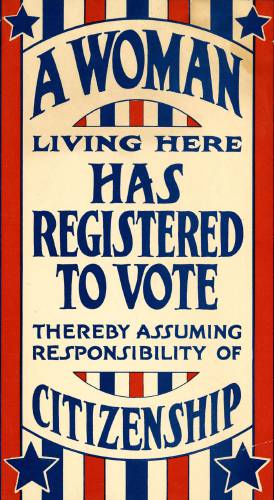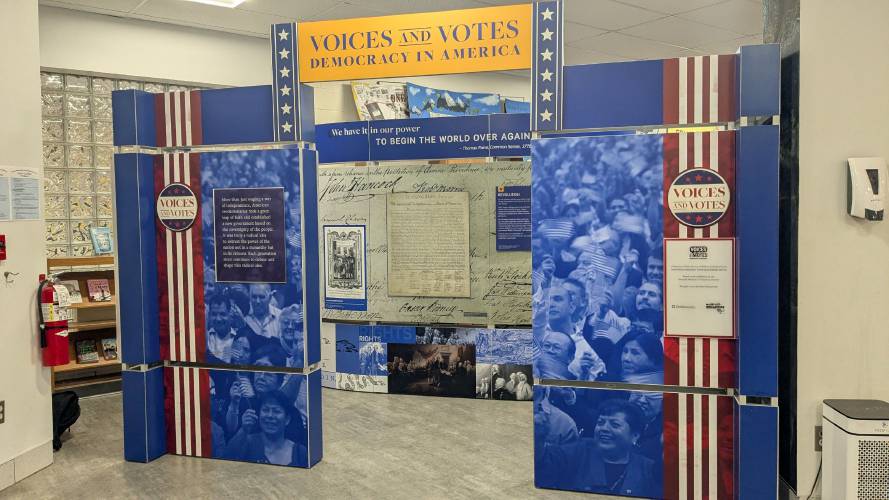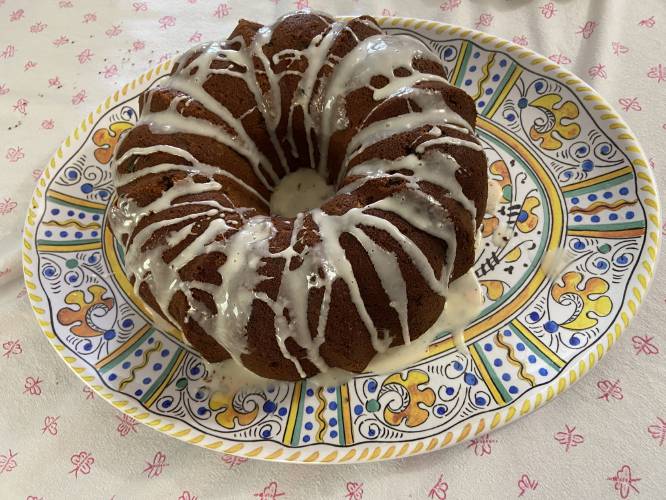Make America cake again: How to bake an Election Cake
| Published: 05-12-2025 2:15 PM |
Food can be a tangible link to history. When we taste a recipe from the past, we experience that past in a specific, often delicious, way.
Last fall, three social studies teachers at Mohawk Trail Regional School in Buckland and I learned that we had been awarded a grant to bring a Smithsonian exhibit to the school and create programming to go with it.
I knew almost immediately that I wanted some aspect of the programming to be food related. Luckily, the teachers — Bethany Basal, Catherine Glennon, and Julia White — thought this was a good idea.
The exhibit is called Museum on Main Street: Voices and Votes. It explores the history of voting in this country. We consequently decided that our food piece would revolve around election-day bake sales.
In my own hometown of Hawley (and I presume in other towns), bake sales are a key part of Election Day. Last week’s town election in Hawley wasn’t particularly exciting; there were absolutely no contests.
Nevertheless, many Hawleyites braved the rain to come to the Town Office to vote, visit with neighbors, and patronize the bake-sale table. My contribution, oatmeal-cranberry cookies, went fast.
The FedEx man stopped by as he always does when the “bake sale” sign goes up. He didn’t have anything to deliver, but he always likes to pick up something to sweeten his route.
We originally thought that we would ask the culinary students at the school to prepare vintage recipes and then tell visitors about the process.
Article continues after...
Yesterday's Most Read Articles
 ‘A whole lot of fun’ on the water: Christmas in July boat parade returns Saturday
‘A whole lot of fun’ on the water: Christmas in July boat parade returns Saturday
 New role focused on downtown development in Northfield, Turners Falls and Shelburne Falls
New role focused on downtown development in Northfield, Turners Falls and Shelburne Falls
 Several area departments put out Northfield house fire
Several area departments put out Northfield house fire
 Erving man, 60, found dead in Montague Plains Wildlife Management Area identified
Erving man, 60, found dead in Montague Plains Wildlife Management Area identified
 Firefighters partner with Jumptown to practice water rescues in Orange
Firefighters partner with Jumptown to practice water rescues in Orange
 Trio unopposed for Greenfield City Council seats
Trio unopposed for Greenfield City Council seats
Unfortunately, it turned out that the culinary program wasn’t active this semester. We decided we would still have some bake-sale items but tie them into a larger program.
The program, which will take place this Thursday, May 15, at 5:30 p.m. in the school library, is called “Food for Thought.”
The main course will be a panel discussion about the nature of community in our rural area. We have a general sense that New England towns don’t have the sense of identity they once did.
Few people work in their town’s business district, if their town even has one. As our populations age, fewer residents have children in local schools … and those schools have changed and will continue to change with regionalization.
If a majority of residents once worshiped at one or two churches, they no longer do so. Groups like the Lions Clubs and the V.F.W. are dwindling. In short, there are fewer common experiences to bind people together than there once were.
Our panel will discuss these changes, led by Anne Gobi, the governor’s director of rural affairs, and Mick Comstock, a retired congregational minister who lives in Shelburne Falls.
Individual members of the panel will then discuss their own efforts to create community in new ways: through school sports and school committees, through agriculture, through theater.
And everyone — panelists and audience members alike — will sample our election foods. These will include vintage recipes for ginger cookies and pumpkin bread baked by students who work in the school’s café, along with donuts prepared by Hawley’s Doughnut Queen, Juanita Clark.
My contribution to the proceedings will be an Election Cake. Thought to have originated in Connecticut, these cakes date from the time when the New England states were colonies, although they were also popular in the early days of the American Republic.
Voting was something to celebrate then. Alas, only male property owners could vote, including African American male property owners after 1780 here in Massachusetts. Women and non-property owners would have to wait for suffrage. They were allowed to bake, however.
Election cakes were more or less forgotten by 1900. The practice was revived by bakers in 2016, when the phrase “Make America Bake Again” took the internet by storm.
The original election cake was a yeast-risen, spicy cake with dried fruits and booze. To modern eaters it may seem half bread, half cake.
My challenge while baking was to make an election cake without alcohol since it was to be served in a school. Happily, Marie Pellissier, the program officer at the Massachusetts Foundation for the Humanities who is overseeing our work along with the Smithsonian, is a culinary historian.
Marie sent me an election-cake recipe she had found on the internet that had no alcohol in the cake, although it did have some in the glaze.
I adapted the cake recipe slightly (I love to tinker) and made my glaze with fruit juice instead of alcohol. The resulting cake won’t last as long as 18th-century election cakes, but it will serve a nice crowd on Thursday.
I hope readers will join us at Mohawk Trail Regional School for the food and the discussion. I recommend coming early to tour the Smithsonian exhibit, which is worth seeing. To learn more about the exhibit and future programming, visit www.mtrsd.org/Museum-on-Main-Street.
While you’re eating your Election Cake, ponder these words by Chef George Formaro: “Election Cake isn’t just a recipe; it’s a journey into the heart of early America, a taste of the communal spirit that once celebrated our young democracy.”
(Adapted from the blog “Christina’s Cucina” by TinkyWeisblat and Marie Pellissier.)
Ingredients:
4 cups flour
2 cups dried fruits (I used dried cranberries and golden raisins)
2/3 cup lukewarm water
1 package active dry yeast (2 1/4 teaspoons)
1/2 teaspoon white sugar
1 cup (2 sticks) sweet butter at room temperature
2 cups brown sugar, firmly packed
2 eggs
2 teaspoons cinnamon
1/2 teaspoon ground ginger
1/2 teaspoon nutmeg
3/4 teaspoon salt
1 teaspoon baking powder
1 tablespoon vanilla
1 cup buttermilk
1 1/2 cups confectioner’s sugar
enough orange juice to make a glaze; start with 2 tablespoons and slowly add more
Instructions:
Grease and flour a standard bundt pan.
Measure the flour into a bowl. Place the dried fruits in a medium bowl, and toss 2 to 3 teaspoons of flour on them. Mix well.
Pour the lukewarm water into the bowl of a stand mixer, and sprinkle the yeast and the white sugar on top. Allow the mixture to stand for a few minutes until it bubbles up.
Mix in 1 cup of the flour. Add the butter, and mix well.
Stir in the brown sugar, followed by the eggs. Blend well, then add the spices, the salt, and the baking powder. Stir in the vanilla.
Next, stir in the remaining flour and the buttermilk alternately, starting and ending with flour. Gently add the floured fruits.
Spread the batter in the prepared pan. Cover it with a slightly damp dish towel, and let it rise until it comes almost (but not all the way) to the top of the pan. Ideally, this will take about an hour. Toward the end of the rise preheat the oven to 350 degrees.
Bake the cake for 50 to 60 minutes, until a toothpick inserted into the middle of the cake comes out clean. Let the cake cool on a rack for 20 minutes and then invert it out of the pan and onto the rack. Cool thoroughly.
Whisk together the confectioner’s sugar and the juice to create a glaze, and spoon the glaze over the cake. Serves 10 to 12 voters.
Tinky Weisblat is an award-winning cookbook author and singer known as the Diva of Deliciousness. Visit her website, TinkyCooks.com.









 ‘Everybody wants to tell their story’: Ten historical societies participating in Hilltown History Trail, Aug. 2
‘Everybody wants to tell their story’: Ten historical societies participating in Hilltown History Trail, Aug. 2 Meet the Bluebird Lady of Birnam Road: Northfield resident shares avian hobby with neighbors
Meet the Bluebird Lady of Birnam Road: Northfield resident shares avian hobby with neighbors ‘Like I'm standing in a room of giants’: Meet Elana Casey, new associate director of the Augusta Savage Gallery at UMass Amherst
‘Like I'm standing in a room of giants’: Meet Elana Casey, new associate director of the Augusta Savage Gallery at UMass Amherst Valley Bounty: The joy of blueberry season: Sobieski’s River Valley Farm in Whately has been growing blueberries since 1977
Valley Bounty: The joy of blueberry season: Sobieski’s River Valley Farm in Whately has been growing blueberries since 1977
